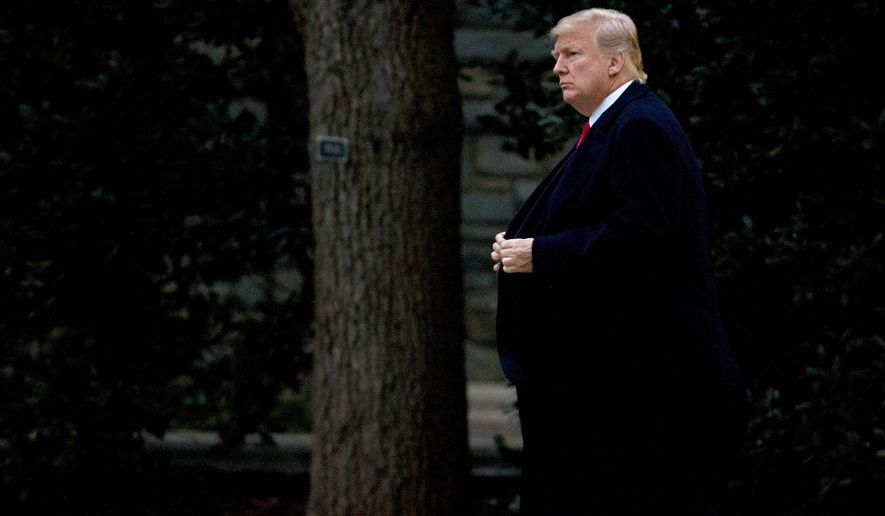President Trump has been willing to accept almost anything to close the deal on his giant tax cut bill before Christmas, including staying mum about a measure that would allow illegal immigrants to pocket the more generous child tax credit included in the package.
Illegal immigrants have been collecting the payoff from the “refundable” tax credit for years because of an IRS interpretation of how the rule was drafted. The Republican-controlled Congress this fall had a chance to correct that in the tax code overhaul that in the Senate version doubled the child tax credit to $2,000 and expanded eligibility.
The House bill increased the child tax credit to $1,600 and upped the income cutoff to receive it.
Both bills neglect to require that the worker have a Social Security number to claim the credit but require only that the qualifying child have a Social Security number.
Under those conditions, illegal immigrant workers with children who benefit from birthright citizenship — a relatively common phenomenon among America’s estimated 12.5 million illegal immigrants — could cash in.
The measures fly in the face of Mr. Trump’s get-tough rhetoric on illegal immigration and his “America first” agenda, Temple University law professor Jan C. Ting recently wrote for the Center for Immigration Studies, a think tank in Washington.
“Before the Senate voted on the Tax Cuts and Jobs Act, Donald Trump said, ‘A vote to cut taxes is a vote to put America first. It’s time to take care of our workers,’” he wrote. “Allowing illegal aliens who are not authorized to work to get refundable tax credits does the opposite.
“While the IRS has the authority, if not the mandate, to deny these credits to illegal aliens, Congress should resolve any ambiguity,” he said.
When asked about it, the White House deferred to Congress.
“That’s a better question for the House and Senate,” said a White House spokesman.
Mr. Trump also has eased off of other tax reform goals he once backed in the name of deal-making and of getting a badly needed political trophy win on Capitol Hill for his first year in office.
His campaign proposals to cut the corporate tax rate from the current 35 percent to 15 percent was bumped up to 20 percent in the House and Senate bills that emerged this fall.
PHOTOS: Sticky fingers: Stars caught shoplifting
The president then made the 20 percent corporate rate the nonnegotiable level until lawmakers started suggesting 21 percent or 22 percent in their search for revenue to fund other priorities.
“The focus is on getting the lowest corporate rate possible,” said White House press secretary Sarah Huckabee Sanders. “Fifteen [percent] is better than 20, 20 is better than 22 and 22 is better than what we have. We are going to continue to push, but we are not going to negotiate that from the podium.”
The goal remained to get “the lowest corporate rate we can,” she said.
The White House has signaled a willingness to keep the current structure of seven individual tax brackets instead of simplifying the code to three or four brackets as originally proposed.
The goal to fully repeal the estate tax and the alternative minimum tax were replaced with partial repeals as the bills worked their way through the House and Senate.
Mr. Trump has kept his focus on the big picture of delivering tax cuts to businesses and middle-class families — and on doing it by Christmas.
“I think we’re going to have a fantastic tax bill,” Mr. Trump said last week at a Cabinet meeting. “The middle class gets a tremendous benefit, and business, which is jobs, gets a tremendous benefit.”
George Mason University law professor David K. Rehr, who teaches legislative advocacy and strategic leadership in Washington, said Mr. Trump is playing the Washington game.
“It is one of the those positions where, yes, he is the president, he has negotiating room and he can press for what he wants, but at the end of the day — having been at the Congress a long, long time — Congress is going to put a plan together and then the president must decide up or down,” he said. “And if the bill says ‘tax reform’ on it, he’s going to sign it.”
Mr. Rehr said that even the illegal immigrant loophole, which has the potential to outrage Mr. Trump’s base, has to be negotiable to get a bill though the legislative process.
“Since we don’t have line-item veto, the White House will try to get that out. In the end, maybe that is a trade-off for something else,” he said. “But whatever bill is passed by both bodies and goes to his desk, there are some things he may have to swallow hard on.”
Alfredo Ortiz, president of the Job Creators Network that is promoting Mr. Trump’s tax cut plan for small businesses, said the president is making necessary compromises.
“The one thing President Trump fully understands is it is the ‘Art of the Deal,’ he said, referring to the title of Mr. Trump’s how-to business book. “In the end, if there is a bill — and there will be a bill — on the president’s desk for him to sign by Christmas Eve, then it is a win. And that’s what we are really focused on.”
Mr. Ortiz, who has been involved in tax cut talks at the White House and on Capitol Hill, said the only nonnegotiable item left for the president is getting the bill finished on schedule.
“The red line is it must get done this year,” he said. “I don’t think there will be any conversation or any negotiation if it looks like this things goes into 2018.”
• S.A. Miller can be reached at smiller@washingtontimes.com.




Please read our comment policy before commenting.